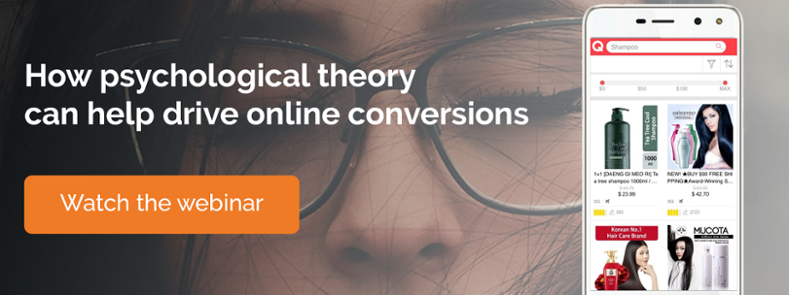From clicks to cart: making smarter use of product images
In today’s crowded online marketplace, we all face the same challenge: how do we attract and convert shoppers? While increased media spend is an almost guaranteed way of attracting more people to an online platform, getting them to actually buy is a whole different ball game. Many online retail giants aren’t forthcoming with behavioral data, so knowing how visitors think and behave from the time they land on the platform until they check out, is a blind spot for many of us.
Tapping into consumer psychology can be one way to tackle this challenge. SKIM’s psychological distance theory, developed in collaboration with bright minds at the psychology department of New York University, can help find ways to drive online conversion.
We believe that by applying this theory to product images you can lower the psychological distance between the consumer and the brand, and drive conversion as a result.
We recently put our theory to the test by teaming up with Qoo10, a leading eCommerce site in Asia and Singapore’s #1 online shopping destination. Here we share the results of the experiment and how you can apply our theory to optimize product content and your eCommerce strategy.
SKIM’s Psychological Distance Theory Explained
Different levels of psychological distance alter people’s perception of reality. Lower psychological distance allows people to focus on your product or service concretely instead of abstractly, giving them a clear and tangible idea of what they are going to get. This impression, ultimately, allows the consumer to “experience” rather than see the product.
This tends to generate more desirable product judgments and helps create a match between what the consumer is looking for and what your brand offers.
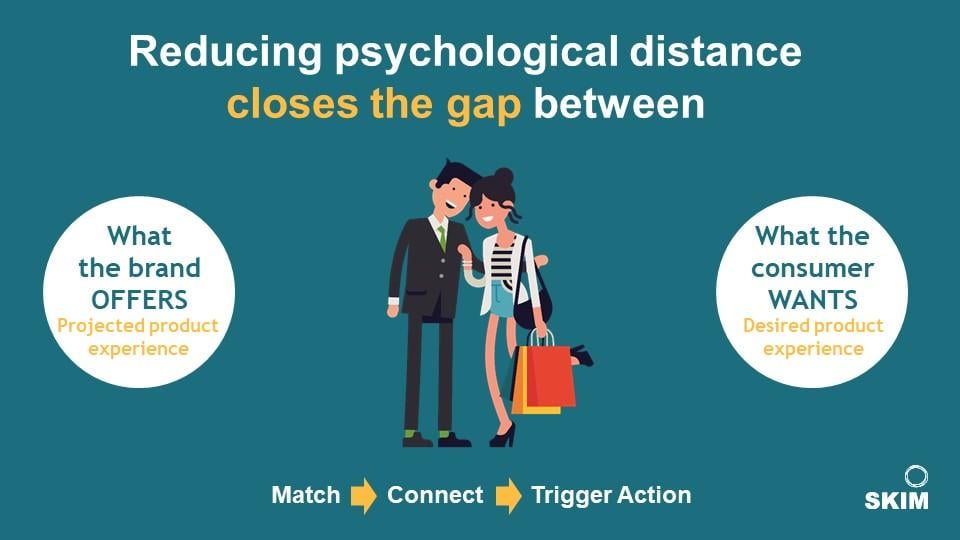
Overcoming eCommerce marketing challenges
 At the ESOMAR Asia Pacific 2019 Conference, Hyunwook Cho, a founding member of Qoo10 and eCommerce pioneer, shared how the industry has evolved in recent years.
At the ESOMAR Asia Pacific 2019 Conference, Hyunwook Cho, a founding member of Qoo10 and eCommerce pioneer, shared how the industry has evolved in recent years.
Cho described the shift we are witnessing in eCommerce today as both “awesome and shocking.” After optimizing online media spend, we “expect to see an increase in sales,” he said.
However, once shoppers view the product online, there are still serious barriers that must be overcome to convert that view into a sale.
- Barrier #1: An infinite amount of options makes your product harder to find
Unilever took the lead in solving this product content challenge. Working closely together with Cambridge University and SKIM in a later stage, they developed the Cambridge Standard for Mobile Ready Hero Images. By making brand, format, variant and size much easier to recognize, hero images proved to be an effective tool for tackling this findability issue. Conversion rates were up, and Unilever hero image guidelines were adopted by the broader FMCG industry.
The existing hero image guidelines help consumers understand what physical product they are going to get. This successfully reduce the psychological distance between the product and the consumer, but we believe we can do even better than this.
To fully close the gap, we recommend doing more than only communicating a product’s physical characteristics. There also needs to be a “match” in terms of the desired and promised product experience.
Think of the clear picture you have in your mind of how you want your hair to look after using shampoo, or the delicious taste explosion you imagine when choosing which ice cream to buy. Convincing consumers your product will deliver on the desired product experience is difficult in general but particularly difficult online.
- Barrier #2: People cannot touch, smell or taste your product
In a physical store you can pick up a product, perhaps even try samples. Online, all senses, expect for vision and hearing, are muted. This environment makes it difficult for consumers to get a clear idea of the product experience they are going to get, which creates uncertainty and lowers the probability of a sale.
While the digital nature of eCommerce is the very source of this problem, it provides the solution at the same time. The flexibility of digital content allows us to include written or visual sensorial cues that subconsciously trigger memories, emotions, and automatic reactions stored in memory.
Triggering these prior experiences through the use of sensorial cues leads to the generation of mental imagery, which allows you to imagine how a product and its related benefits look, feel, taste, sound or smell. Or in other words, it let’s people experience rather than merely see the product, and lower psychological distance as a result.
Putting SKIM psychological distance theory into action
As an early innovator in the eCommerce space, Cho had been optimizing Qoo10’s product images for a few years, with promising results. He recognized the importance that visuals could have in generating more return from its media spend.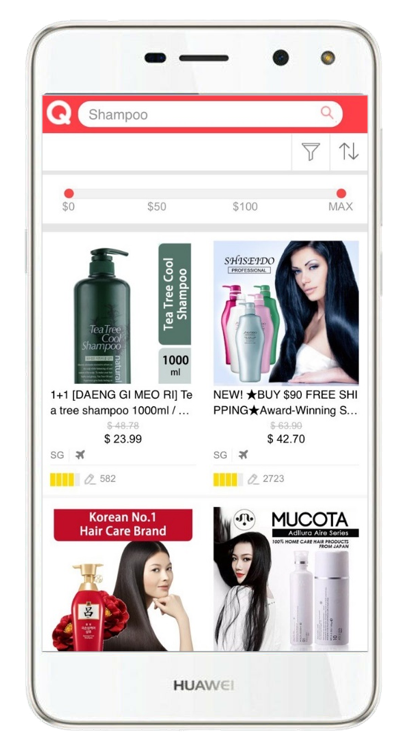
After several passionate discussions about visuals and eCommerce during our shared time at INSEAD, we decided to put our theory to the test: Can we increase conversion by using images to minimize the psychological distance between the desired (consumer) and offered (brand) product experience?
With SKIM DigiShop, we replicated Qoo10’s mobile shopping environment and conducted shopping simulations with 1,779 mobile shoppers. Experiments were conducted for shampoo and chocolate snacks. In both experiments, we changed the images of five separate brands to represent different levels of psychological distance.
The results were remarkable.
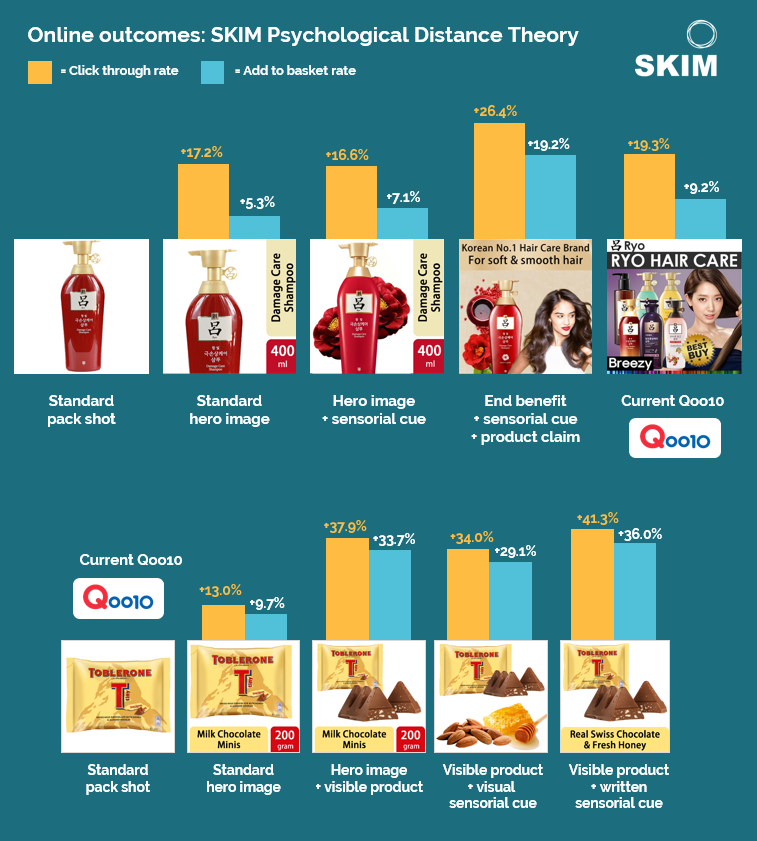
In both categories, the new images strongly outperformed traditional pack shots and the existing hero image standard in terms of click-through and add-to-basket rates. For shampoo, using both words and visuals to bring the desired product experience to life, had the biggest positive impact. For chocolate snacks, image performance jumps when the product is taken out of the packaging.
These results make a lot of sense when you consider the context. The packaging is just a means to an end and what people are actually buying is the product inside, which they will consume and hope to indulge on. What better way to tap into this desired product experience than actually showing the product in an attractive way and subconsciously triggering relevant sensorial cues.
After these encouraging results we turned our attention to the actual Qoo10 platform to test our theory in a live e-commerce setting. Qoo10 replaced the images for three shampoo brands to determine how accurate the experiment results are compared to actual online sales.
The in-market results were in line with our simulated shopping experiments and even resulted in 64% more page views and 40% more sales for the best performing image. It should be noted here that the visuals that were replaced were already containing several desired elements, and even greater gains could be expected versus traditional pack shots.
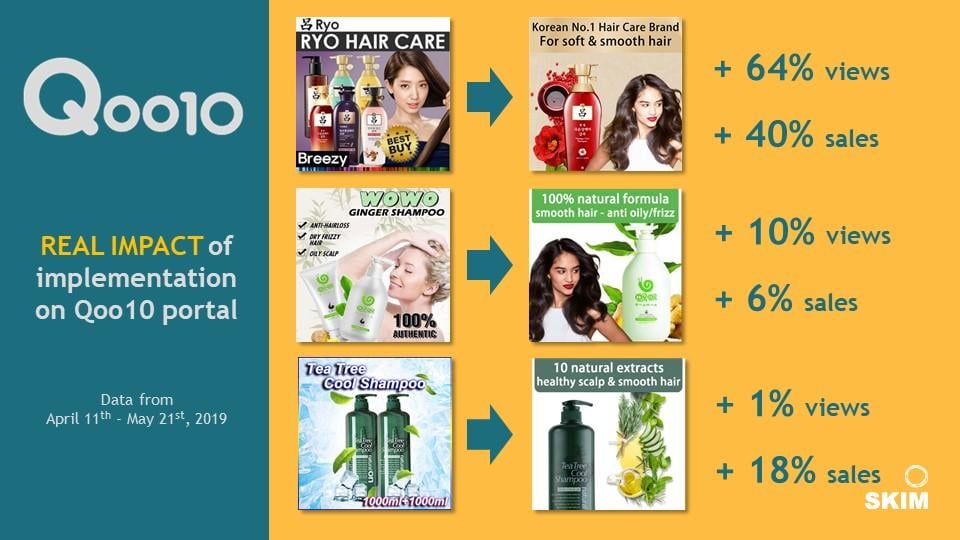
“It was very shocking to me that when you start to actually invest in the image quality, there was a huge improvement in sales,” Cho said after seeing the real-world results. “Under the old paradigm we focused on media spend while under the new paradigm, we focus on the thumbnail [product] images to actually increase the outcomes of the ad campaigns. With the same amount of ad spending, we could easily see 2 – 3 times more conversion.”
Key takeaways for eCommerce success
We have come a long way in our quest to optimize our eCommerce strategies, but one area remains overlooked. By using psychological theory to better understand how consumers make decisions we now know that tremendous gains are still to be made. Using product visuals to bring people’s desired product experience to life, reduces the psychological between brand and consumer, and increases conversion as a result.
What eCommerce challenges are you facing?
About Hyunwook Cho
Hyunwook Cho is one of Asia’s e-commerce pioneers and a founding member of Qoo10, a leading Asia e-commerce platform and Singapore’s #1 online shopping destination. Cho holds an Executive MBA from INSEAD. During their shared time at INSEAD, Cho and Paul had many passionate discussions on how to sell products online, which eventually lead to this collaboration.


